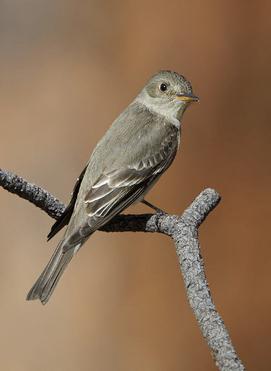WESTERN WOOD-PEWEE OR-201
Willamette Valley, William L. Finley National Wildlife Refuge, Oregon
June 14, 4:53 a.m.
Sunrise at 5:27 a.m.
First heard as we entered the Rockies, then with us all the way to the Pacific, the western wood-pewee.
This western wood-pewee is in rapid dawn song, with 48 songs in the first minute alone! He alternates the expected tswee-tee-teet (A) and bzeeyeer (B) songs, the sequence during the first 30 seconds alone being A B A B A B A B A B A B A B A B A B A B A B A B.
The next 30 seconds is essentially the same, except at 0:48-0:50 two tswee-tee-teet songs occur back to back. The faster the western wood-pewee sings at dawn the more likely he is to simply alternate his two songs, and as he slows, he introduces short strings of two tswee-tee-teet songs--at least that's my hunch, based on just two males here at the Finley refuge and on the similar behavior of the eastern phoebe.
This male also has a third rarely used song, the tsweeeeeer (C). It can be heard at 1:47, 2:40, 3:43, 3:52, 5:09, and 5:57. What's that all about? Perhaps it's a call note used in other contexts during the day?
As I watch the sonagrams float by and listen to each, I am intrigued by that bzeeyeer song. We think of flycatchers as having innate songs that vary little, yet the duration of this bzeeyeer song is considerable. The second song (at 0:04) is 20% longer than the first (at 0:02), and the song at 6:08 is 35% longer than the first. Clearly there's more to these songs than a simple rote memory playing out precisely time after time.
Background
Another western wood-pewee in dawn song, spotted towhee, Swainson's thrush, purple martin in dawn song (3:15-3:25, e.g.), bullfrogs.

Photo by Robert Royse
